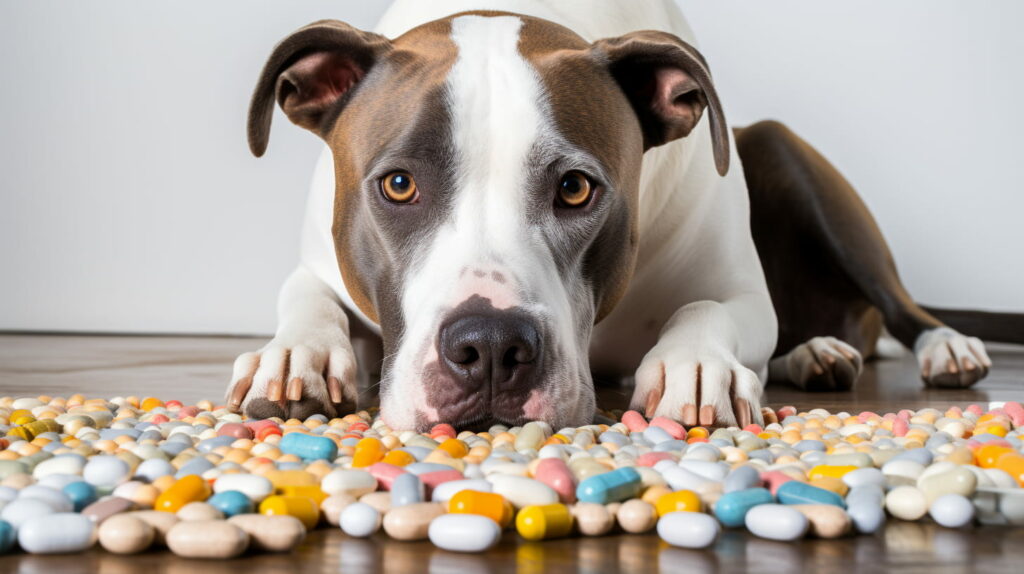As a pet owner, you know how difficult it can be to get your dog to take medication. Dogs can be notoriously stubborn when it comes to swallowing pills, and it can be frustrating to struggle with them every time they need medication. However, with a few simple tips and tricks, you can make the process much easier and stress-free for both you and your furry friend.
In this section, we will discuss some of the challenges of giving pills to dogs and provide an overview of the tips and tricks that will make the process easier for pet owners, helping you to ensure your dog always gets the medication they need.

Key Takeaways:
- Administering pills to dogs can be challenging, but it's important to ensure they get the medication they need.
- There are several reasons why dogs may resist taking pills, including the taste and texture of the medication.
- Building a positive association with pills is crucial and can be achieved through training and rewards.
- Effective pill-swallowing techniques include hiding the pill in food, using a pill dispenser, and asking your vet for liquid medication if available.
Understanding Your Dog's Resistance to Pills
Administering medication to dogs is often a challenging task for pet owners, as some furry friends may develop a resistance to pills. Understanding why dogs have a hard time taking medication can make the process easier for both you and your pet.
One of the primary reasons why dogs resist pills is their sense of smell. Dogs have a keen sense of smell, and they can quickly detect any foreign odor. For dogs, pills often have a strong smell that makes them unappealing. Additionally, dogs have sensitive taste buds, and pills can have a bitter taste that can cause discomfort.
Another reason why dogs resist pills is the physical sensation of swallowing them. Dogs have a unique way of swallowing; they use their tongue to push food and water towards the back of their throat, forcing it down. Pills, on the other hand, are usually small and lightweight, making them difficult for dogs to swallow.
Fortunately, there are ways to address your dog's resistance to pills. By understanding your furry friend's behavior, you can develop effective strategies to make the process easier.
To address the smell and taste of pills, you can try disguising them in food. Wrap the pill in a slice of cheese, a piece of meat, or a spoonful of peanut butter. The strong odor and flavor of the food can mask the smell and taste of the pill, making it more appealing to your dog. You can also try grinding the pill and mixing it with your dog's food.
To address the physical sensation of swallowing pills, you can try different techniques. One technique is to insert the pill in the back of your dog's mouth, beyond the tongue's reach, and then tilting the head upward while stroking the throat. This technique can trigger the swallowing reflex and make sure the pill goes down. Another technique is to use a pill pocket, which is a soft treat with a slot for the pill. This method allows you to hide the pill in a tasty treat that your dog will willingly eat.
Creating a Positive Association with Pills
Getting your dog to take a pill can be a daunting task, and it's not uncommon for them to develop a negative association with medication. However, with a few tricks up your sleeve, you can gradually help your furry friend accept the pill with less stress and fuss.
Tip 1: Hide the pill inside a treat or food item that they love. For example, you can use a spoonful of peanut butter or a piece of cheese. Just make sure your dog doesn't chew the treat and spits out the pill.
Tip 2: Try coating the pill with a thin layer of butter or vegetable oil to make it easier to swallow.
Tip 3: Use positive reinforcement to reward your dog for taking the pill. Praise them with treats, cuddles, and kind words to reinforce the positive association with medication.
Tip 4: Administer the pill during or after a meal when your dog is more likely to be hungry and willing to accept food items.
Remember, creating a positive association with pills takes time and patience. Be consistent with your approach and reward your dog for their efforts. With enough practice and positivity, your furry friend will gradually become more willing to take their medication.
Pill Swallowing Techniques for Dogs
Giving pills to dogs can be a challenging task, but there are techniques that can make the process easier for pet owners. Here are some practical tips to ensure successful pill swallowing:
| Technique | Description |
|---|---|
| Hide the pill in food | This is a popular method for giving pills to dogs. Wrap the pill in a piece of cheese, peanut butter, or meat, making sure your dog swallows it whole. Be careful not to use a food that dogs could choke on, like sticky peanut butter. |
| Use a pill pocket | Pill pockets are soft, chewy treats designed specifically for hiding pills. Place the pill inside the pocket and give it to your dog like any other treat. Pills can also be hidden inside a small piece of bread or a soft dog treat. |
| Crush pills and mix with food | If your dog won't take pills whole, try crushing them and mixing them with a small amount of wet food. This method usually works well with medications that can be crushed, but be sure to check with your vet first. |
| Administer the pill directly | This method involves opening your dog's mouth and placing the pill at the back of their throat. Hold their mouth closed and gently stroke their throat to encourage them to swallow. Be careful not to place the pill too far back, as this can cause your dog to choke or gag. |
Remember, it's important to always follow your vet's instructions when giving your dog medication. Some medications require specific administration techniques or should be taken with food. With patience and the right approach, you can make giving pills to your furry friend a stress-free experience.

Making Pill-Giving Easier for Dogs
Pill-giving can be a daunting task for pet owners. Luckily, there are many tips and tricks to make the process easier and less stressful for both you and your furry friend. Here are some additional strategies to help make giving pills to your dog a breeze:
- Use pill pockets or wrap the pill in a small amount of food your dog loves. This can help mask the medication's taste and make it more appetizing for your pup.
- Try using a pill dispenser or syringe to administer the medication. These tools can help ensure that your dog takes the pill properly and make the process less messy.
- Give positive reinforcement to your dog after taking the pill, such as praise, pets, or treats. This can help create a positive association with the experience and make it more likely that your dog will be cooperative in the future.
- Be patient and persistent. It may take some trial and error to find the perfect method that works for both you and your dog.
Remember, giving pills to your dog doesn't have to be a stressful experience. With some patience and dedication, you can make the process easier and ensure that your furry friend gets the medication they need to stay healthy.
Training Dogs to Take Pills
If your dog is resistant to taking pills, training can help turn things around. Here are some steps to follow:
- Start with positive reinforcement: Before introducing pills, create a positive association by giving your dog tasty treats. You can gradually incorporate the pill into the treat, ensuring your dog tastes it.
- Practice with a fake pill: For the first few training sessions, use a fake pill to help your dog adjust to the process. Practice opening your dog’s mouth and gently placing the fake pill on their tongue.
- Graduate to the real thing: Once your dog is comfortable with the fake pill, it's time to move on to the real thing. Use a pill splitter to ensure you’re giving your dog the right dose.
- Burrito wrap: The burrito wrap method involves using a small piece of bread or cheese to wrap the pill. Gently open your dog’s mouth, place the pill in the back of their mouth and hold their jaw closed while they swallow. Reward your dog with a treat.
- Pill pockets: Pill pockets are a great way to administer medication quickly and easily. They come in various flavors, and pills can be hidden inside. Simply insert the pill in the pocket and give it to your dog as a treat.
- Liquid medication: If your dog is still struggling to swallow pills, ask your vet if the medication is available in liquid form. Liquid medication can be mixed with food or, using a syringe, administered directly into the dog's mouth.
Training takes time and patience, but with the right approach, you can teach your dog to take pills without stress or struggle. Remember to always reward your dog for their cooperation, and never punish them for resisting. Consistency and positivity are key!
Using Natural Remedies to Make Pill-Taking Easier for Dogs
Administering pills to dogs can be challenging and stressful for pet owners, but natural remedies can provide an effective solution. If you're looking for alternative methods to make pill-taking easier for your furry friend, you're in the right place. Below, we've compiled a list of natural remedies that can help with medication acceptance.
1. Peanut Butter
Peanut butter is a popular remedy for administering pills to dogs. Its sticky texture helps to hide the pill and the taste is irresistible to most dogs. Simply place the pill in a small ball of peanut butter and let your furry friend lick it up.
2. Cheese
Another tasty option for giving pills to dogs is cheese. Its strong aroma makes it an excellent pill-hiding tool. Wrap the pill in a small piece of cheese and give it to your dog as a treat.
3. Coconut Oil
Coconut oil has natural anti-inflammatory and antiviral properties that can help with various health issues. It's also a great option for pill administration. Simply melt a small amount of coconut oil, mix the pill into it, and give it to your dog as a treat.
4. Greenies Pill Pockets
Greenies Pill Pockets are a popular commercial product that make giving pills to dogs a breeze. These treats are designed to hold pills in a hidden pocket, making them easy to administer. They come in different flavors and sizes to suit your dog's preferences.
Remember, natural remedies can be a helpful tool for administering pills to dogs, but always consult with your veterinarian first. They can recommend the best natural remedy based on your dog's specific needs and health condition.
Overcoming Your Dog's Resistance to Pills
Giving pills to dogs can be challenging, as some dogs may resist taking medication due to various factors such as taste, texture, or size of the pill. However, it is essential to ensure that your furry friend takes their medication as prescribed by the vet for their health and well-being. Here are some techniques to overcome your dog's resistance to pills:
| Technique | Description |
|---|---|
| Crushing Pills and Mixing Them with Food | Ask your vet if the medication can be crushed, and mix it with your dog's favorite food. This technique can help mask the flavor and texture of the medication and make it easier for your dog to consume. |
| Using a Pill Pocket | Pill pockets are treats with a pouch that can hold medication. These can be purchased at pet stores or online. They come in different flavors and sizes to accommodate various types of medication. Simply insert the pill inside the pocket, and give it to your dog as a treat. |
| Coating Pills with Peanut Butter or Cream Cheese | Coating the pill with a high-value treat such as peanut butter or cream cheese can make it more palatable for your dog. Make sure to check with your vet if these treats are safe to use for your dog. |
| Using a Pill Syringe | A pill syringe can help administer medication directly into your dog's mouth. It can be useful for dogs that refuse to swallow pills. Place the pill inside the syringe, and inject it in the back of your dog's mouth. Ensure that your dog swallows the pill by gently holding their mouth closed and stroking their throat. |
Remember, it is crucial to be patient with your dog when administering medication. Avoid forcing pills down their throat or punishing them if they refuse to take their medication. Instead, try different approaches until you find what works best for your canine companion.
Effective Methods for Pill Giving to Dogs
Administering pills to dogs can be a challenging task, but with the right methods, you can make the process smoother and less stressful for your furry friend. Here are some effective techniques to help you give pills to your dog:
- Hide the pill in a treat: Many pet owners have found success in hiding pills in a tasty treat such as cheese, peanut butter, or a soft dog treat. The key is to make sure your dog is hungry, so they are more likely to swallow the treat without detecting the pill.
- Crush the pill: If your dog refuses to take a pill, try crushing it and mixing it with food. However, it's important to check with your vet if it's safe to crush the pill as some medications lose their effectiveness when crushed.
- Use a pill pocket: Pill pockets are soft treats with a pocket designed to hold a pill. They come in different flavors and sizes and can make giving pills to your dog easier.
- Apply a pill syringe: Pill syringes can be helpful, especially for liquid medications. The syringe allows you to administer the medication directly into the back of your dog's mouth, ensuring they receive the correct dosage.
Remember, always follow your vet's instructions when giving medication to your dog. If you're unsure about anything, don't hesitate to ask your vet for guidance. With patience and practice, you can help your dog accept medication more willingly and ensure they stay healthy and happy.
Conclusion
Giving pills to dogs can be a challenging task, but it is essential to ensure their health and well-being. Throughout this article, we have discussed various tips and tricks to make the process easier for both pet owners and their furry companions.
While there is no one-size-fits-all solution, the key is to be patient, persistent, and positive. Training your dog to take pills may take some time, but it is crucial to keep trying different methods until you find what works best for your dog.
Remember to create a positive association with pills by offering treats, using pill pockets, and rewarding your dog for taking their medication. It is also helpful to understand your dog's behavior and resistance to pills and address their concerns accordingly.
If traditional methods do not work, natural remedies and alternative approaches may be worth considering. However, always consult with your veterinarian before introducing any new supplements or treatments.
In conclusion, with patience, training, and positive reinforcement, giving pills to your furry friend can become a straightforward task. Keep trying, stay positive, and do not hesitate to reach out to your vet for additional guidance and support.
FAQ
Q: How do I get my dog to take a pill?
A: Giving pills to dogs can be challenging, but there are a few tips and tricks that can make the process easier. It's important to understand your dog's resistance to pills and create a positive association with medication. Pill swallowing techniques and training can also help. Additionally, natural remedies and holistic approaches can be beneficial.
Q: Why is my dog resistant to taking pills?
A: Dogs may resist taking pills due to their taste, texture, or past negative experiences. It can also be challenging for some dogs to swallow pills. Understanding your dog's resistance and addressing their concerns is crucial in successfully administering medication.
Q: How can I create a positive association with pills for my dog?
A: Building a positive association between your dog and pills can be achieved by using treats, rewards, and gentle handling. Making medication time a positive experience can help your dog accept pills more willingly.
Q: What are some pill swallowing techniques for dogs?
A: There are several techniques you can try to help your dog swallow pills. These include using pill pockets, hiding pills in food, or using a pill dispenser. It's important to find a method that works best for your dog.
Q: How can I make giving pills easier for my dog?
A: Making the pill-giving process easier for your dog can involve using different methods, such as crushing pills or using liquid medications. It's also important to approach pill-giving with patience, calmness, and a positive attitude.
Q: How do I train my dog to take pills?
A: Training your dog to take pills involves using positive reinforcement, repetition, and gradually increasing the difficulty level. By following step-by-step instructions and being consistent, you can successfully train your dog to take pills.
Q: Are there natural remedies that can help with pill-taking for dogs?
A: Yes, there are natural remedies and alternative approaches that can make the pill-taking process easier for dogs. Holistic approaches, supplements, and herbal remedies can help with medication acceptance. It's important to consult with your veterinarian before trying these options.
Q: What strategies can I use to overcome my dog's resistance to pills?
A: To overcome your dog's resistance to pills, it's important to understand their behavior and address their concerns. This can involve creating a positive association, using gentle handling techniques, and seeking professional guidance if needed.
Q: What are some effective methods for giving pills to dogs?
A: There are various effective methods for giving pills to dogs. These include using pill dispensers, pill pockets, or mixing pills with food. It's important to find the method that works best for your dog's individual ne


